With the holidays near, we need to give thanks for the many opportunities that 2019 should provide to higher education. The next few years (including 2019) bring the promise of a new and exciting economy, one based heavily on automation and efficiencies and fueled by the once-mocked Millennials (born between 1980 and 1996; now roughly 22 to 38 years of age) and the special people of Generation Z (or the iGeneration segment, born between 1997 and 2002 and now 16 to 21 years of age). By 2020, Millennials and Generation Zers will represent more than half of the workforce. By 2030, more than two-thirds of the workforce will be from these two cohorts[i].
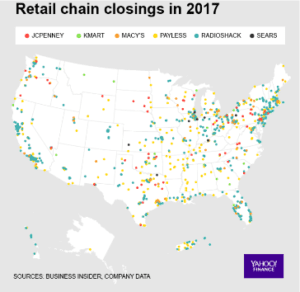
The new economy and movement to e-commerce will continue to rattle the brick-and-mortar business of retail. As big-box retailers like Walmart (through Jet.com), Target, and Best Buy, among others, redefine their e-commerce against the likes of Amazon, new opportunities will persist as retailers continue to shutter their retail outlets. In 2017, nearly 8,000 stores closed[ii] and another 4,000+ are estimated to close in 2018[iii]. This follows on the heels of 5,077 store closures in 2015 and 2,056 in 2016[iv]. Low unemployment and growth across several sectors absorbed many losing their jobs in retail. A strong economy saw health services, professional and business services, manufacturing, and the leisure and hospitality segment absorb those losing jobs to more online retail[v]. 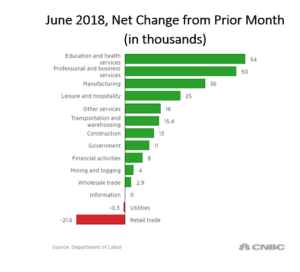
Many industries are forecast to change rapidly over the next few years. Higher education providers can seize the opportunity to provide more educational credentials through more aggressive engagement with those who will ultimately fuel the new economy. Or, they can let others–such as business and industry–build their own programs, and allow more Massive Online Open Courses (MOOCs) and micro-credentials cut into the value of their larger and potentially unwieldy degrees.
One solution has been to create more full degrees online, with a heavy emphasis on professional master’s degrees. While this is certain to extend the life cycle of the bachelor’s and master’s degree, especially in the Science, Technology, Engineering, and Math (STEM) fields, the pipeline to serve the new economy will remain unfilled as employers will need more progressive supply chain managers, programmers and coders, data and intelligence analysts, drone operators, cybersecurity experts, home health professionals, alternative energy workers, and so many others.
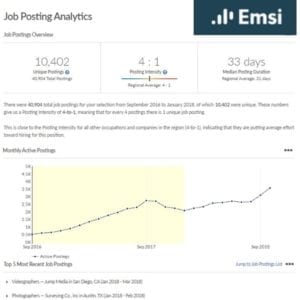 A quick environmental scan shows the following forecasts, developments, and observations:
A quick environmental scan shows the following forecasts, developments, and observations:
- Solar installers will grow by 105% by 2026, going from 11,300 installers in 2016 to 23,100 in 2026[vi]. The Bureau of Labor Statistics also shows that wind turbine service technicians will also increase by 96% during that time, as should many other renewable energy-related occupations.
- Emsi data shows more than 10,000 unique job postings with the keyword “drone” in them, as well as monthly increases of active job postings with the same word[vii]. Drones will be used by first responders, photographers, security personnel, and agricultural specialists, and will also benefit from expected growth in the construction and building sectors within the United States, many of which are a result of weather disasters, new engineering and transportation projects, and the growth in commercial real estate.
- In addition to the transportation of goods from warehouses directly to the customer, the transportation of people is destined for change. Young people are choosing not to make larger purchases, automobiles included, and have bought into the sharing economy. These consumers are also fueling a movement to alternative and convenient forms of transportation. For example, General Motors (GM) recently announced layoffs, acknowledging the movement to self-driving and electric cars. As a result, a new workforce is needed, and new talent will be recruited to follow this trend. Also, GM announced plans for an electric bike[viii] to further meet the needs of Generation Zers and Millennials. Ford quickly followed suit by acquiring an electric scooter company[ix]. Further disruption is also forecasted in the already disrupted mobility sector as Google’s subsidiary Waymo plans to launch a self-driving taxi or ride-hailing service in 2019[x]. With approximately two million Uber drivers[xi] and nearly four million Lyft drivers worldwide,[xii] Waymo, as well as Uber’s future self-driving ride-hailing service, will further disrupt the industry.
While these are just a few industries experiencing rapid change, higher education has an opportunity to be a more active partner in creating the future. I believe that higher education still feels that it is the hub of all things education. In reality, it continues to maintain a strong hold on many credentials related to STEM and business education, but has lost its grip on much of what it had. Highly bureaucratic and slow-moving approval processes coupled with changing content has put colleges and universities at a disadvantage in the new economy. More and more degrees appear to have grown obsolete, with colleges and universities choosing to ignore them rather than fix them through certificate refreshers that often come in a noncredit format.
Where higher education has adapted is with online degrees, but that took nearly a decade to see scaled adoption. Also, the supply of degreed online education may soon exceed demand unless institutions start creating content and credentials, like badges and certificates, that are better suited for the new economy.
For the new economy, higher education can focus on badges and certificates and other micro-credentials that may be better suited for these changes; educating those migrating from retail to new industries; retraining those with obsolete degrees of decades past; and appealing to generations that received more frequent awards and rewards as they matured.
Higher education can do a reset by reviewing its existing portfolio for relevance, designing new programs and credentials for jobs already evolving in the new economy, and creating new and nimble processes that qualify and validate new curriculum for new jobs. For this opportunity, we should give thanks.
[i] WSJ/Deloitte CFO Insights, March 2018
[ii] Yahoo Finance, January 8, 2018
[iii] BusinessInsider, April 7, 2018
[iv] Credit Suisse Report, 2017.
[v] CNBC report and June Department of Labor Report, June 2018
[vi] Bureau of Labor Statistics, 2016 National Employment Matrix
[vii] EMSI Job Analyst
[viii] Automotive News, November 2, 2018
[ix] USA Today, November 13, 2018
[x] New York Post, November 14, 2018
[xi] Garrett Camp (Uber Co-founder) blog, June 20, 2017
[xii] CNet, January 16, 2018
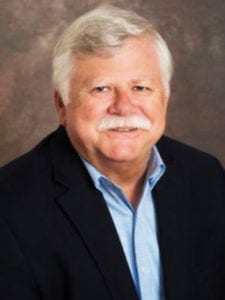 Dr. James K. Broomall will retire as associate vice provost, professional and continuing studies & online initiatives at the University of Delaware effective January 15, 2019. Jim holds a secondary appointment in the College of Education and Human Development. Before returning to Delaware in 1988, Jim held program and leadership roles at the University of North Carolina, Chapel Hill and the University of Nevada, Reno.
Dr. James K. Broomall will retire as associate vice provost, professional and continuing studies & online initiatives at the University of Delaware effective January 15, 2019. Jim holds a secondary appointment in the College of Education and Human Development. Before returning to Delaware in 1988, Jim held program and leadership roles at the University of North Carolina, Chapel Hill and the University of Nevada, Reno.Google has dominated search for 20 years. But results today are far too often tainted with information that is incomplete, misleading or false. MIT aims to address that problem with the knowledge graph Underlay.
I recall the very early days of Google’s search engine — just after it changed its name from BackRub (really!). It was renamed Google after googol — a numeral one followed by 100 zeroes — and the URL was found within the domain stanford.edu. Google quickly outdistanced its peer search engines. But others survived; even in 2018 there are alternatives to searching with Google — many with interesting and useful features.
From the beginning of the web in 1992, there were concerns and questions about the validity of information online. The challenge has only become worse as more and more individuals and organizations with partisan motivation and malign intent have taken to the web to promote misleading, biased, untrue and malicious material. Libraries over the years have developed guides to help students assess the validity of internet-sourced information. I developed a modest reference metasite 20 years ago that I have regularly updated and shared with my students to help them assess the sites they find.
Though I update the site occasionally, one favorite, yet underutilized, strategy remains prominent. It is the “link” search term operator. For example, go to Google and enter a search for “link:www.upcea.edu” or “link:insidehighered.com” (without the quotation marks). This will render the sites that link to the URL, helping you to determine which other sites find the original site to be valid and useful.
One of the key value points of Google is the knowledge graph. It’s the box of condensed information that appears to the top right of results in the full web version and at the top of the mobile version. In October 2016, Google reported that their knowledge graph included more than 70 billion facts. It has become increasingly important as the knowledge graph is used to feed answers to questions voiced on Google Home and Google Assistant.
Yet, the value of Google search increasingly is tarnished as more and more nefarious players have become sophisticated in promulgating their materials on sites that look more like places that we have come to trust. And, of course we are constantly combating sites that install malware and steal information from browsers.
This has not gone unnoticed at the Massachusetts Institute of Technology, where Danny Hillis, SJ Klein and Travis Rich are developing Underlay — a new knowledge base. As described at the MIT site, the concept of Underlay is to provide deeper citations of sources in order to better inform users:
While much knowledge is uncontested, the Underlay stores contested or contradictory statements, along with detailed context and chains of provenance. Evaluations of fidelity or accuracy can make use of this information, and can themselves be stored in other layers. The focus on provenance and iteration supports refinement, revision, and replication of observations. The structured granularity enables alignment of unrelated datasets, bulk analysis, and machine learning.
All of this is done in machine-readable format so that advanced AI tools can further refine, format and apply the results. At this point the Underlay is still very much under development. However, it is a great example of what may become a new generation of search engines that is able to sort through the fact, opinion and misleading information of the “post-truth” era.
We can look for more developments in the search engine field in the coming months.
This article was first posted November 14th in Inside Higher Ed’s Inside Digital Learning.
With Halloween only recently past, ghosts still are among us in society. They live among and can frequent colleges and universities, even our professional, continuing and online education units through “ghosting.” Ghosting is a term often associated with younger generations regarding relationships. However, the phrase has recently started entering the workplace with new hires not showing up for their first day or potential employees not showing up for interviews. However, what about the ghost inquirer to the university, one that is seeking professional, continuing, or online education?
Ghosting is basically ending a relationship without notification, despite the other member’s attempts to communicate. UPCEA’s Marketing and Enrollment Management Seminar addressed many issues related to marketing and prospect and inquiry management, including enrollment funnels and digital marketing. With Generation Z quickly moving in as a major adult learner segment and with Millennials becoming managers and decision-makers, understanding the drivers and reasons for ghosting is critical in a changing economy.
Ghosting is often done to avoid conflict or to keep options open. It can also be a form of passive aggressiveness in a situation. It also may be preventable for PCO units and their enrollment managers and help to convert prospects, as well as reduce costs by not having to service true non-targets. Some of the reasons for ghosting in the inquiry process could include:
- Being asked too much information too quickly
- A prospect inquiring with many similar providers (as they have leverage and options)
- Not having enough information and therefore embarking into an uncertain relationship
- Being interested but waiting to hear back from other providers before making a decision
- An inability to say “no, not interested”
UPCEA recently conducted a survey of young people, those between the age of 22 and 37 and found that almost half had ghosted another person in a relationship and approximately 40% have ghosted a business or establishment they’ve contacted but are no longer interested in. Many have also reported contacting a college or university and ghosting them, as opposed to formally ending the relationship or keeping options open for the future.
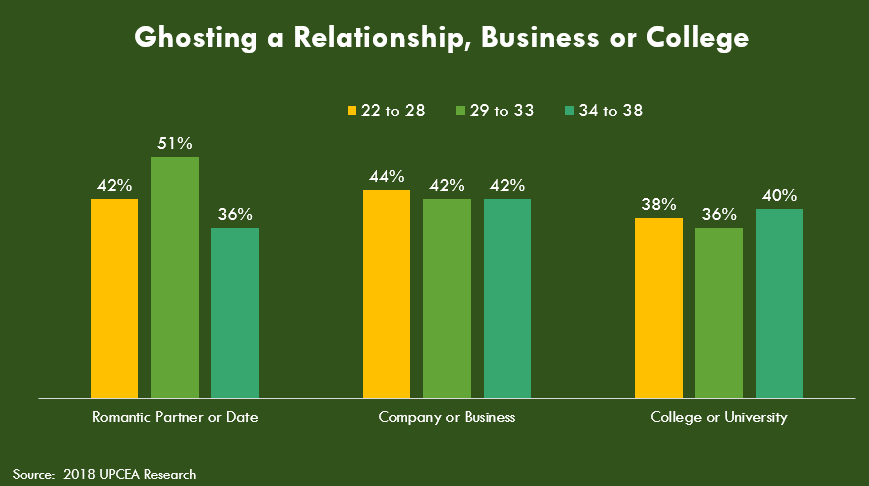
There could be many reasons, some of which could include an awkward or under-developed relationship that has been created. PCO units can work to minimize this by better targeting their messages, strategizing their touch points and designing their communications more toward the target market.
Universities can also avoid moving too fast in the relationship. In working with a number of UPCEA members, the UPCEA Center for Research and Strategy has found websites targeted to unintended audiences, excessive contact forms, or mismanaged social media efforts. In the case of the contact form, younger audiences will leave information behind, but not too much. The figure to the right shows that young people are willing to provide their emails, but not necessarily other information. When a prospect is early in the inquiry process, a physical address is not necessarily needed, unless they show true interest.
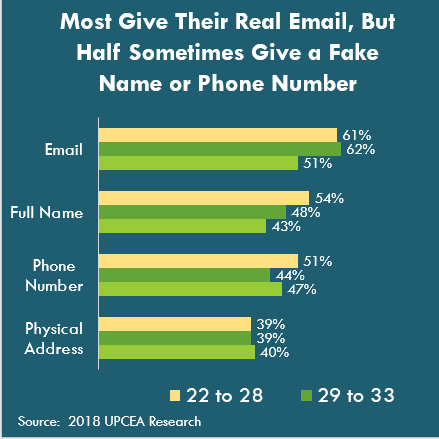
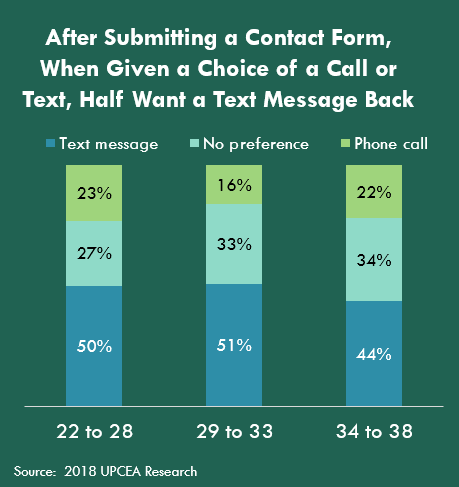
Asking for a physical address too early may inadvertently leave an abandoned form or one with misinformation. In fact, many young people surveyed may leave an incorrect cell number in the case of a form requiring it unnecessarily. In fact, when the cell phone is a voluntary field and the inquirer fills it out, then that alone is valuable information that they may desire a text message follow-up or an immediate call. The research shows that after giving their cell phone number about half prefer a text message over a phone call.
The research also shows that after basic contact information, that survey respondents are willing to tolerate a few more questions, most likely around areas of interest or information on how they would like to be contacted, but not necessarily personal or identifying information or excessive questions. Colleges and universities are used to asking prospects to fill out applications or forms. Much of this is a result of a greater level of patience for the format from other generations, but also from a “power” or “leverage” perspective. Colleges and universities had more leverage to ask for this information. With greater educational choices, asking for too much information could in fact create a competitive disadvantage for the institution. A Generation Z’er might say “Heck, I’m not filling out this form…College A and B don’t ask for it.” Information in today’s age has to be earned and not demanded.
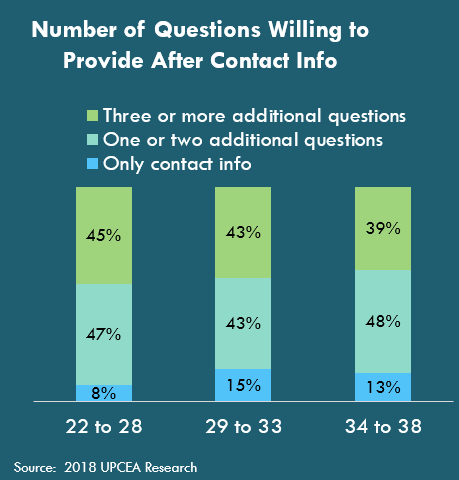
PCO units and their marketing and enrollment management groups need to examine their processes. They must not get lazy in asking for too much information too soon and as a result, scare their prospects away and create “ghosting” relationships. By examining processes and centering the enrollment management process around this new generation, ghosts are likely to show themselves (as they did with Jennifer Love Hewitt in the popular television series “The Ghost Whisperer”) or go to a different realm, one where they will do less damage or use no additional resources.
Affordable degrees at scale have arrived. The momentum behind this movement is undeniable, and its impact will be significant.
How many times have we been told that major change in our field is on the near horizon? Too many times, indeed.
The promises of technologies and practices have fallen short more often than not. Just seven years ago, I was part of the early MOOC movement and felt the pulsating potential of teaching thousands of students around the world in a single class. The “year of the MOOC” was declared in 2012. Three years later, skeptics declared that the MOOC had died an ignominious death with high “failure” rates and relatively little recognition by employers.
However, the skeptics were too impatient, misunderstood the nature of MOOCs and lacked the vision of those at Georgia Tech, the University of Illinois, Arizona State University, Coursera, edX and scores of other institutions that have persevered in building upon MOOCs’ premises to develop high-quality, affordable courses, certificates and now, degrees at scale.
No, these degrees are not free, but they are less than half the cost of on-campus versions. No, they are not massive in the hundreds of thousands, but they are certainly at large scale with many thousands enrolled. In computer science, the success is felt across the country.
Georgia Tech alone has enrolled 10,000 students over all in its online master’s program and is adding thousands of new students each semester in a top 10-ranked degree program costing less than $7,000. Georgia Tech broke the new ground through building collaborations among several partners. Yet, that was just the beginning, and many leading universities have followed.
Coursera now offers a dozen online degrees from top universities at half the normal tuition or less. Eight more degrees are currently offered through edX.
I recently attended the third “Affordable Degrees at Scale” symposium at Georgia Tech. This small, limited-invitation gathering provides an insider’s view of the technology, pedagogy, design and financial aspects of reinventing higher education in an affordable, effective and worldwide format. Sidebar conversations abound on how to fine-tune delivery, design, engagement and effectiveness. It has the feel of the gathering of start-up entrepreneurs who are sharing their “secret sauce” as well as their goals for new initiatives with peers whom they respect.
Much credit goes to Nelson Baker, dean of professional education at Georgia Tech and incoming president of UPCEA, who created this symposium. Along with Associate Dean Yakut Gazi, they brought together the national leaders in this field and created an open discussion atmosphere through the implementation of “Chatham House Rule” that protects anonymity and respects confidentiality in the symposium.
A highlight of each of the three symposia I have attended has been to share some minutes with Professor Ashok Goel, who is well-known for his creation of the virtual teaching assistant “Jill Watson,” and her later iterations as well as nano-tutors that populate his courses.
It is his work and the work of others who share his passion to bring effective learning practices to scale that has made “at-scale” learning possible by engaging students and meeting their needs through artificial intelligence. As AI technologies are deployed, there is the prospect that such programs will more fully offer personalized learning than on-campus programs.
This advancement in higher education is expanding rapidly. Know that these initiatives will impact your recruitment and enrollment in graduate programs in the coming years.
Master’s tuition at half price or less among top-ranked universities in at-scale programs with essentially unlimited capacity is a factor that all of higher education must consider. If your university is not engaged in planning for this, perhaps you should lead the discussion today.
This article first appeared October 31st, 2018 in Inside Higher Education Inside Digital Learning.
An online degree program can be a big investment. Luckily for 37-year-old northern Virginia resident Grant Clough, his employer offers workers $8,000 per year toward tuition reimbursement for those who choose to continue their education.
Clough, director of talent acquisition at AARP, initially considered an MBA program, possibly on campus. But he ultimately decided against pursuing another business degree, in part because he studied accounting as an undergraduate.
He then came across the online Master of Studies in Law at Wake Forest University, and it turned out that his employer would be covering nearly all his tuition. With the online format, he would also have more flexibility to study around his schedule.
“Working in human resources, it’s fairly a compliance heavy profession,” Clough says. “A lot of what we do revolves around laws and making sure that we process and plan around those. And so, this just kind of seemed like a natural fit.”
When choosing an online degree program, experts suggest consulting a school’s academic or enrollment advisers and other resources to learn more about different ways to cut costs.
Employer tuition reimbursement. Many online students work full time and want to accelerate or change their careers. As more and more institutions offer more degree programs online, it’s becoming increasingly common for companies and organizations to pay for some or all of their employees’ tuition, says Julie Uranis, vice president for online and strategic initiatives at the University Professional and Continuing Education Association.
“Many years ago, employers were cautious when it came to online learning, but after hundreds of studies showing the efficacy of online learning, employers see financing the educational attainment of their employees for what it is: an investment that pays dividends,” she wrote in an email.
